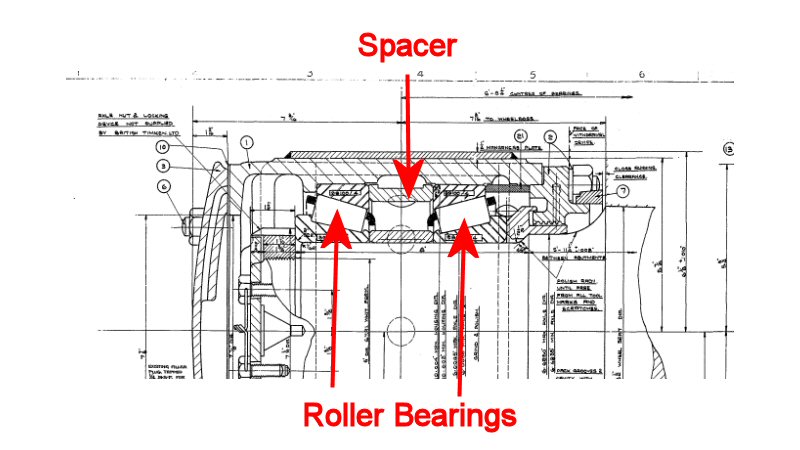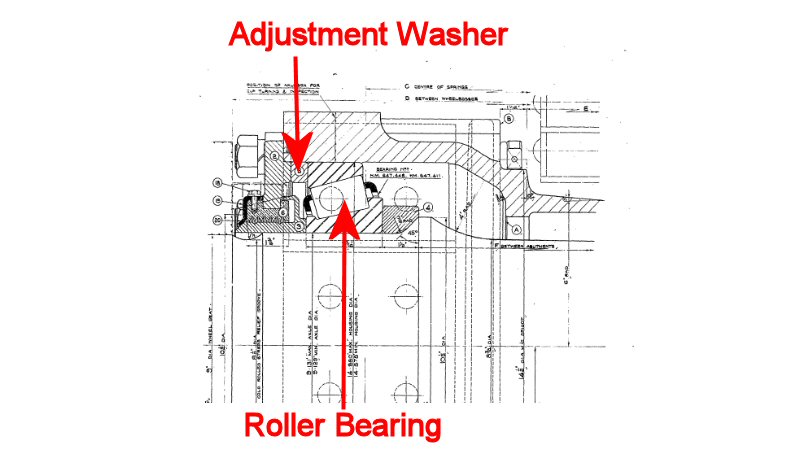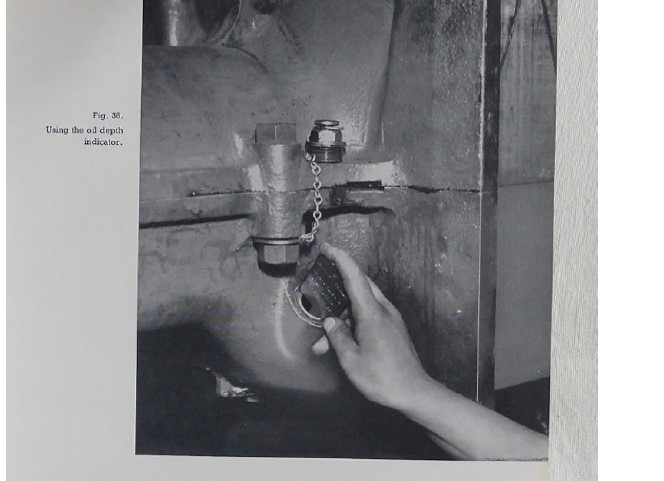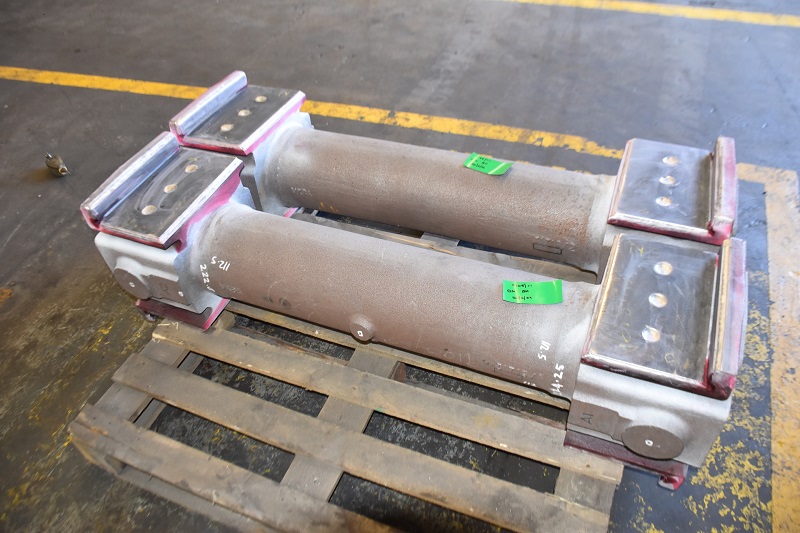Axlebox Lubrication
The majority of the British Railways 4-6-2 locomotives were fitted with roller bearings in the axleboxes; the exception being a few of the Class 7 Britannias which were fitted with plain bearings on the driving wheels and trailing trucks. E.S. Cox (the officer responsible for design) says "Much argument attended the question as to whether the coupled axleboxes should have plain or roller bearings." [1] Throughout his career, Cox had seen the steady improvement in plain axlebox design from the times when a hot axlebox averaged one engine per year [2] to a time where "100,000 miles could be run by these boxes, between repairs". [1] In contrast, roller bearings had been developed by American and Swedish companies and offered the promise of a service life of 2,000,000 miles. However, they were considerably more expensive.
For the trailing (or pony) truck and the tender wheels, the axleboxes were outside the wheels. For the bogie and driving wheels, the axleboxes were inside the wheels. The latter poses a problem in that, should the bearings fail, the only way to replace the bearings is to press the wheel off the axle. This process can damage the wheel or axle which can mean replacement, especially in the case of the axle.
For the trailing truck and tender axleboxes, each axlebox contains a pair of opposed taper roller bearings, each bearing race being separated by a spacer. The width of the spacer is vital to ensure the correct end float of the bearings. Anyone who has worked on MGB wheel bearings will recognise the principle.

The bogie and driving wheel axleboxes are different. As the axleboxes are inside the wheels, the 2 axleboxes are kept apart by a tube cast into the whole assembly. As the tube is similar to a cannon, these are called cannon boxes. The early design of cannon boxes were split horizontally (as fitted to 60163 Tornado) whereas the BR locomotives were fitted with solid cannon boxes. Here are 72010's bogie cannon boxes waiting for stage 2 machining.
This arrangement allows the use of only one bearing per side. The bearings are kept opposed by the axle (the spacer in the Trailing Truck design) in the cannon tube. An adjustment washer, between the end cover and the outer race, is in halves to allow the adjustment to be removed and then to be machined to provide the correct end float.

All of the roller bearing axleboxes were designed to be lubricated by oil. A high viscosity, cylinder grade oil is used. Oil filler holes were provided on each axlebox end together with a drain plug. 2 condensing vents (either side of the boss for Western Region contact type Automatic Train Control) were provided for breathers. The Timken manual shows how the oil level was measured using a level indicator.

Oil consumption was low compared with plain bearings
- E S Cox states "Finally, mention must be made of the very low oil consumption with roller bearings, about 3 oz. per 5,000 miles for each coupled box.". [3]
- Bill Harvey (shedmaster at Norwich responsible for the Britannias on the Great Eastern express services says) "The average amount of oil added weekly to top-up the driving axle bearings of each of the ten (Class 7) locomotives over a period of 48 weeks (including 2 complete oil changes on account of emulsification) was slightly less than one pint." [4]
- An interesting indication of the low oil consumption is provided in the minutes of the Locomotive Standards Sub Committee "Difficulty has been experienced in moving axlebox spring hanger pins and spring buckle pins on B.R. locomotives having roller bearing axleboxes where, due to absence of leakage of oil, these pins are not in the same lubricated condition as obtains with plain bearings." [5] At the bottom of the driving wheel axlebox is an eye for the pin that secures the axlebox to the main suspension spring. With plain axleboxes, the oil leakage prevented the pin from corroding. With roller bearings it proved necessary to add a grease way to the pin so that it could be kept lubricated so that the pin could be removed.
The change came in 1960 when the LSSC meeting minutes state :-
...."it is recommended that grease lubrication be adopted on all roller bearing axle boxes of BR standard locomotives. This course is expected to result in an appreciable saving in fitting staff time" [6] By 1960, getting staff to work in the conditions of a steam locomotive shed was becoming a major problem for British Railways. By transferring the task of lubrication away from fitting staff, this saved fitters time and provided a cost saving as the work could be done by less skilled staff.
Modification to grease lubrication was initially thought to be straightforward :-
- The filler hole plugs were replaced by grease nipples.
- The condensing vents were removed and the holes blanked off.
However problems were experienced with 3 Class 6 locomotives in Scotland which experienced roller bearing failure. In 1961, the LSSC minutes record "The firms (i.e. Timken) report dated 24/3/61, circulated to all CM & EEs, referred to the greater temperature differential arising with grease lubrication which tends to offset the initial end play in the assembly, even to the extent of causing end loading unless the initial clearance is adequate. It was therefore suggested that the initial end clearance should be increased for grease lubrication to a figure .018" - .020" as against the original agreed limits of .008" - .012" in the case of oil lubrication." [6]
Oil lubrication involves filling the oil to a level. The remaining space inside the axlebox is air. As the axlebox warms and cools, air can be vented or breathed in through the breathers. A standard facility on automotive engines before the introduction of emission controls. As the rollers revolve through the bottom of the axlebox they are immersed in the oil sump. Grease lubrication presents a different problem in that the axlebox is completely sealed and there is no way of knowing how much grease is inside the axlebox. Therefore, axlebox greasing requires a machine greasing system; grease is pumped in until it starts to emerge from the labyrinth seals around the ends of the axles. E S Cox was not very impressed by this system; a note recorded after a LSSC meeeting states "Grease Lubrication of Roller Bearing Axle Boxes - in answer to a question by Mr Miller, Mr Cox said that it had been agreed to use grease for future designs but that it was left to the regions to decide whether grease can be used for existing boxes. He thought himself that it was absurd to apply grease to cannon boxes which would have to be stuffed full." [7] It is understood that around five gallons of grease are required to fill each cannon box. Once the engine starts to move, grease continues to be expelled from the axlebox. This tends to coat the frames, the underside of the footplating and the motion.
Not all BR Standard locomitives were converted to grease lubrication, a notable exception being 71000 Duke of Gloucester. 71000 spent 7 years at Barry scrapyard in a salt air environment with oil lubricated roller bearings. In restoration "All the roller bearings were in perfect condition but were converted from oil to grease lubrication on the advice of Timken Bearings" [8] Recently 71000 has suffered bearing problems which has required the replacement of 20 sets. In the case of the bogie and driving wheel bearings, this has resulted in axle damage. The main crank axle has had to be replaced.
SSLC have considered the issue of oil versus grease lubrication at great length and have sought advice from a number of ex British Railways staff and Timken Bearings. It has been decided that 72010 will use oil lubrication of all axleboxes.
- The original 1960 decision was primarily a cost saving exercise. It has not been possible to find any technical reason for the change.
- Oil can be sampled easily (by draining a small sample from the special drain plug) and sent for testing.
- Use of oil ensures that the additional weight of 5 gallons of grease in each axlebox (unsprung weight) is avoided.
- The coating of frames, footplating and motion by excess grease is avoided.
- It is difficult to definitively state that oil lubrication will avoid condensation corrosion damage. However, the main advantage is that any water collecting in the axlebox can be drained off easily through the drain plug. This check was part of the 3 to 5 week examination for BR Pacific locomotives.
Reversion to oil is straightforward.
- An oil filler and level will be provided.
- Some form of condensing vent/breather will be required. Only one is needed as the central boss for WR ATC is not required on the cannon box casting.
- The end float appropriate to oil lubrication is required, i.e. .008" - .012"
References
1 British Railways Standard Steam locomotives - E S Cox - Chapter 5
2 Locomotive Panorama - E S Cox - Chapter 2
3 Paper 447 read to the Institute on 20 April 1944 by E.S. Cox "Locomotive Axleboxes" - see page 316 (original)
4 Bill Harvey's 60 Years in Steam - Chapter 13.
5 Locomotive Standards Sub-Committee Meeting Minutes September 1954 - minute 503
6 Locomotive Standards Sub-Committee Meeting Minutes May 1961 - minute 976
7 Swindon notes post Locomotive Standards Sub-Committee Meeting September 1958
8 71000 Duke of Gloucester - The Impossible Dream - Peter King


